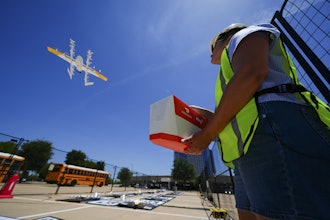GETRAG FORD is one of the largest manufacturers of automotive transmissions in the world. As part of its Lean manufacturing initiative, the company implemented Zebra Material Flow Replenishment system to automate parts processes throughout its 2 million square foot assembly plant in Cologne, Germany. The results, according to Ralf Vierkotten, supervisor, logistics and material handling, GETRAG FORD, include inventory down from seven days to two. He also reports increased manufacturing floor space utilization, improved manufacturing plant floor demand visibility and a one third reduction in daily forklift trips. And he adds that the company has almost completely eliminated line downtime due to parts shortages.
Consider those achievements in terms of Lean’s seven wastes: in this case their positive impact on excess inventory, non-value add processing, waiting, unnecessary motion and transportation.
On excess inventory, for example, the result is reducing inventory carrying costs by $750,000 while the company also reports significant savings in handling and storage costs. As for unnecessary motion, the labor productivity and equipment utilization figures speak for themselves – as does the fact that, for example, production line operatives no longer need to leave their workstations to help search for parts, or help material control determine the correct parts.
Equally, waiting has been massively impacted – and as a result, downtime slashed – entirely due to sorting out problems with parts shortages by enabling supplier visibility of changing production demand. The facility manufactures six different transmission varieties for global brands, including Ford, Mazda and Volvo – with output of more than one million assemblies per annum for OEMs in Argentina, China, Europe, Japan, South Africa, Taiwan, the Philippines and US. As a result, many different parts are consumed at line-side, all of which have to be well orchestrated from a supply standpoint, particularly to avoid the wastes of excessive movement and WIP inventory.
How Does It Work?
Apart from the Material Flow Replenishment application itself, Zebra implemented: a wireless messaging infrastructure of 220 active RFID WhereCall buttons, each of which is associated with a specific part number on the assembly line; a network of 12 wireless WhereLAN location sensors; and five Åkerstrom rugged mobile computers, mounted on forklift trucks.
As each container of parts is consumed at lineside, the replenishment system communicates a request for another to that location. Specifically, at each location there is a predefined minimum inventory called a recorder point. When inventory reaches that point, the system makes its material request, mostly via wireless push-button or automatic (for robotic or highly automated processes) RFID tags positioned at the operators’ workstations close to the inventory points. It’s similar to an e-kanban system, except that not only does the system support internal and supplier material replenishment requests, but also manufacturing messages, such as requests to support organizations, such as electricians and toolmakers.
The solution tracks the exact time of all part requests, automatically prioritizes them and sends instructions to material handling drivers – whose vehicles are equipped with vehicle-mounted WiFi terminals – telling them where to pick up and deliver the parts throughout the assembly plant. The system also alerts suppliers when parts are needed, with its Supplier Portal allowing them to receive real-time demand signals and ship parts from within the portal. It then manages synchronous flow of those parts from the supplier to the plant warehouse dock door, from the warehouse to the staging lane, and ultimately to the assembly-line operator who originated the request. Hence the outstanding end-to-end impacts on inventory, productivity and waste.
As Vierkotten puts it: “The system moves us a long way toward our ultimate goal of a completely forklift-less production operation, as we are now operating Leaner than ever before. Production-line employees no longer need to leave their workstations to help search for parts or to help material control determine the correct part. All they have to do is push a WhereCall active RFID button, and the system notifies all the required parties – from the line-side to the forklift driver to the internal warehouse – that more parts are needed. This intelligent automated system supports our Lean manufacturing processes as we benefit from real-time inventory consumption and can execute replenishment orders just in time.”
See the original whitepaper at www.zebra.com.























